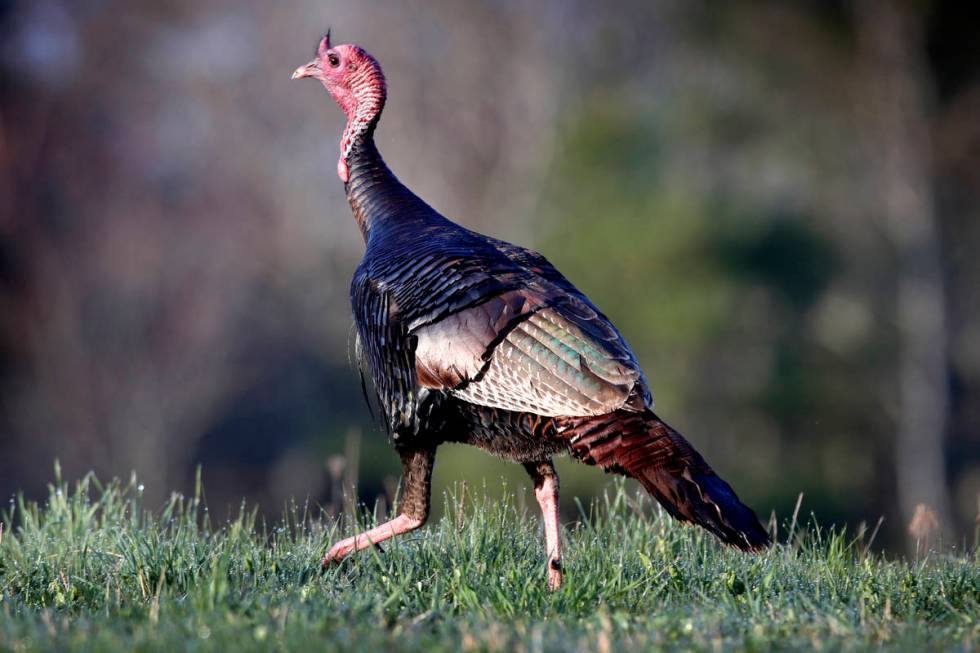State-record turkey hunt product of planning, patience

Crouching as low as he could without crawling, Dave Syphus made his way toward a large bush near the corner of a field where he and his partner had seen a large gobbler in full strut. Reaching the bush, Syphus looked up and was surprised to see the big tom just feet away.
In the hunter’s pocket was his first turkey tag. The ghillie suit he wore was hot, but he had confidence in its camouflaging capability. After all, a rooster pheasant had shared his hiding spot earlier that morning and never knew Syphus was there.
The gobbler’s tail feathers were fanned out wide as he strutted his stuff for the hens, but its tail feathers were all that Syphus could see. The bird was facing the opposite direction. He would have to wait for the bird to stick its head out so he could get a clear shot.
Syphus had been watching the turkeys in this part of Moapa Valley for about 10 years, seeing them for the first time shortly after accepting Chuck Freimanis’ invitation to go bird hunting. Syphus had always been a big game hunter but quickly took to dove hunting. Then the two added quail and ducks to their list of fall hunting interests.
Along the way they became friends with a man who gave them permission to hunt his fields. Fields where wild turkeys gather to feed, and in the springtime participate in their annual mating ritual. That is where the strut comes in.
After learning he had drawn a turkey tag, Syphus and Freimanis invested time in learning more about the turkeys they had been watching. “I told Chuck, ‘I don’t want to just sit in the field and wait for them. I have always been a kind of a hunter.’ So my goal was to try and get it before he made it to his field.”
After patterning the birds’ daily activities and travel routes, “we had it pretty much down to a science,” Syphus said.
On opening day, he donned the ghillie suit his friend had originally purchased with Halloween in mind and set up in the corner of a field where they fully expected gobblers to pass through. “It’s gonna be right here, they’ll come right to you,” Freimanis told Syphus.
But that morning the birds served a change-up and made a wide circle around his hiding spot. Syphus waited for more than an hour but saw only the pheasant that shared his hiding spot.
Syphus left his opening day post and joined his partner in a search for the turkeys. As the day wore on, he passed on some young toms and held his fire when a safe shooting lane was unavailable after seeing something more mature. Eventually they turned back toward the field where the day began.
And that is when they saw the big gobbler. “He’s full-fanned and sitting right where I was,” Syphus said, laughing as he did.
The two instantly recognized the turkey was a large bird. So Syphus put the ghillie suit back on and made his sneak, using the wind to cover any noise he made. Meanwhile, the gobbler strutted.
When the time arrived, and knowing he needed a head shot, Syphus made a gobble sound with his mouth and the bird responded by extending its head straight up. One shot secured the tom.
When the men retrieved the turkey, Freimanis asked, “How’s the beard?” And Syphus answered, “Which one?”
The gobbler had two beards, and it was indeed a large bird. After weighing the turkey and measuring its beards and spurs, it appears the gobbler will be a state record for Rio Grande turkeys. The bird weighed in at 23.8 pounds, the beards total 17.68 inches and the spurs measured 1.5 and .5 inches for a total score of 75.375. The current state record for an atypical turkey is 69.1250.
“To be honest, I wasn’t looking for a record. I didn’t know there was a record out there to be had,” said Syphus.
Freelance writer Doug Nielsen is a conservation educator for the Nevada Department of Wildlife. His “In the Outdoors” column is not affiliated with or endorsed by the NDOW. Any opinions he states in his column are his own. Find him on Facebook at @dougwritesoutdoors. He can be reached at intheoutdoorslv@gmail.com.